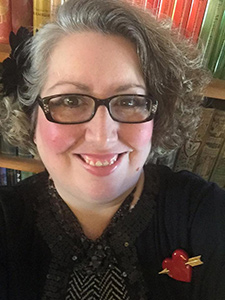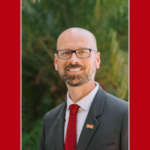
Kim Keeline, SDSU Writers’ Conference Choice Award winner.
An avid reader since childhood, Kim Keeline loves books. So much so, that she and her husband have more than 8,300 in their 1,100-square-foot home. Avid readers are often avid writers, and Keeline certainly is.
While working on her novel, Deadman’s Switch, the first book in a cozy mystery series, she twice attended the SDSU Writers Conference to hone her craft and learn more about the business end of writing. The 2016 conference was her third time attending, and the first time she scheduled an advance reading appointment.
“Before that, I never felt I was close enough to completion on my book to warrant it,” said Keeline.
Advance readings require submitting the first 10 manuscript pages, prior to the conference, to the agent or editor of one’s choice. Conference attendees can also schedule a consultation — a Q&A opportunity to pitch a project and discuss its viability in the marketplace.
With a long history of launching careers by opening doors, the SDSU conference was among the first to pioneer these 1:1 appointments that give writers unprecedented access to top-tier publishing professionals — many of whom interact with unpublished authors only through conferences.
Keeline chose Martin Biro, an editor with Kensington Publishing, and ended up being his pick for a Conference Choice Award. Every year, each agent and editor chooses their favorite project from all the advance readings and consultations that take place over the three-day conference.
Keeline shares her SDSU Writers’ Conference experience and where she is today on her journey to publication:
Are you a writer by profession or is it an avocation?
Writing has to be both a profession and avocation for me, I think, but if you mean do I make a living from my writing, I certainly do not — yet. I have not yet been professionally published. I have a few different paying gigs including as a staff member at San Diego Writers, Ink (a nonprofit dedicated to writers which holds workshops and events every week) and as the general manager of the Electriquettes, the replicas of the 1915 wicker carts in Balboa Park which you can rent on the Prado. I’m also a volunteer steam-locomotive engineer twice a month at the Poway Midland Railroad.
Tell us about the project that brought you to the 2016 SDSU Writers’ Conference.
Deadman’s Switch, which I’m still revising, is set in a fictional suburb of Riverside, Calif. called Tarroco Heights. Liz McKenzie, a young widow of a Chicago police detective, returns to her hometown and begins volunteering at the railroad museum her uncle founded, when she stumbles on the body of a volunteer with a rail spike through his back. She must fight to clear a friend’s name and save the railroad museum from closure before the killer strikes again.
That’s a great pitch. How long have you been working on your novel?
I got the idea back in 2005 or so, but I was working on my dissertation at the time so I jotted notes down but didn’t write it. Then I procrastinated, rewrote the first 40 pages a dozen times over a few years, and then finally wrote the first draft in a month. I then wrote most of the second book in the series in the next month. Revisions of both of these have taken about two years, including a critique group at SDWI. I’m still revising, as I need to tighten up some action and add a character that I realized I needed in later books, plus I changed one major relationship between two characters, which made things more interesting but meant a lot of changes to dialogue.
Care to share the opening line or paragraph?
The opening has changed so much over the years, more than anything else in the book. The version Martin Biro saw was set in Chicago with Liz having dinner with her in-laws and realizing why she needs to move home. He liked it, but also said I had to start the action sooner — with Liz already in Riverside. I had a chapter like that previously but had changed it. I didn’t return to that chapter because it had not been working. Now I start the story with her arrival at the train museum on the first day back in town. I’m not entirely happy with it yet and may cut it down.
Steam is dead and some people think it should stay that way. Steam locomotives were replaced on main line tracks by electric and diesel long before I was born, the modern and sleek taking over from the black, hulking dinosaurs of the industrial revolution.
But to rail fans like myself, the old locomotives are still alive. The compressor on an engine even breathes and sighs like a living being and that’s how trains feel to those who work on them.
As I entered the museum’s gate, I was greeted by the familiar clanging of the wig wag at the level crossing ahead, the red lights flashing and pendulum arm swinging back and forth, beating out its warning. If it were not for the punishing blast of Riverside’s Santa Ana September on a steam crew, I might look down those two sets of parallel silver ribbons of rail, as I had so many times, and see a 60-ton steam locomotive billowing black clouds behind it as it chugged up the grade.
Did Martin Biro give you any suggestions on reworking the first 10 pages?
In that I should delete them entirely, yes. I understood that my desire to explain Liz was delaying things. It’s a common problem among first-time writers and I fell into that trap.
Could you tell he was pretty excited about your 10 pages or was it a complete surprise when you heard your name announced as a Conference Choice winner?
Mr. Biro made it clear he was excited about my idea and I was very energized at the end of our talk. While I secretly hoped I would be chosen, and I had even been bold enough to ask him if he was participating in the award, part of me doubted that my work could ever be chosen. I tend to be pretty hard on myself and did not really expect I would be awarded anything, even if I wanted to be.
Are you still heady with euphoria?
It was very exciting to have my work receive some validation. I hope it’s a sign that I will be able to finish these revisions and get it published.
Was he interested in seeing the complete manuscript?
Mr. Biro did want to see the complete manuscript and I will be sending it to him. I had hoped to have it done by now but two weeks after the conference I took on a 40+ hour/week job on top of the other work I was doing, as I became general manager bringing the Electriquettes back to Balboa Park for rent and it took a lot of time to launch that business. It is starting to calm down now so I hope to get back into a writing habit and finish my revisions.
How did you hear about the SDSU Writers’ Conference?
I first heard about the conference through San Diego Writers, Ink.
Did you attend a workshop that was particularly helpful or outstanding in some way?
It is so hard to choose. I always find something to inspire me or excite me at the SDSU conference.
What do you think is one of the greatest strengths of the conference?
The SDSU Writers Conference is a great venue for writers at all stages of their writing career. There are many new writers in the audience and plenty of programming to help them understand the business and also improve their writing skills, but there are also things of value to the more experienced, including a great chance to network or to meet with agents and editors.
Had you been querying agents and trying to get representation prior to the conference? If so, what had the response been?
I have done a few pitches to agents, mostly for practice. So far, every agent I have spoken to has liked my pitch and said I could send a query or sample pages. When I’ve explained that I was still revising, they told me to send when I’m ready and encouraged me to do it soon.
Did you make a connection with a fellow writer or an editor or agent at one of the mixers or the networking lunch?
Each visit to the SDSU Writers Conference has meant new friends in the writing field and new people on Facebook and Twitter.
What’s the first book that spoke to you as a young reader?
Hard to choose just one! I was a huge fan of Nancy Drew and Trixie Belden as a kid, which led to Sherlock Holmes and Agatha Christie. I also fell in love with The Hobbit when I was in third grade and read it and the Lord of the Rings once a year until I reached college age. I also fell in love with Shakespeare when I was 12 years old, which is what led to my degree in English and my dissertation on Shakespeare’s plays; even though I stopped most of my academic work a few years ago and started doing marketing, social media, and writing, I still love Shakespeare and am the editor of an online Shakespeare news blog, The Shakespeare Standard.
Who’s your favorite author (or top three if it’s hard to choose one)?
I can’t choose authors any more than I can choose the first book that spoke to me — I love too many books. Here are a few authors I love: Shakespeare, Jane Austen, George Eliot, L.M. Montgomery, Agatha Christie, and Dorothy L. Sayers.
What keeps you going in the pursuit of your writing goal?
I love the stories that keep coming into my head — and I want to see if others will love them too. I have notes for seven books in this series, four books in a different mystery series, two kids’ books, and a few other stand-alone mysteries. Ideas are not the problem — it’s finding time to write and revise them until they’re good enough for others to read.
Anything you’d like to add?
Thank you, SDSU Writers Conference staffers — I know how much hard work goes into an event like this and I really appreciate the good job you guys do!
The 33rd Annual SDSU Writers’ Conference is Jan. 20-22, 2017 at the San Diego Marriott Mission Valley. Register now for three amazing days that could change your writing life.




